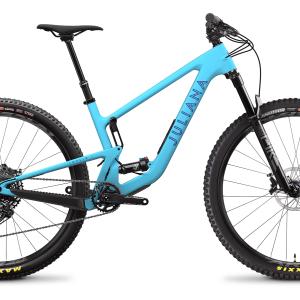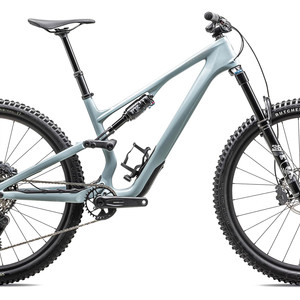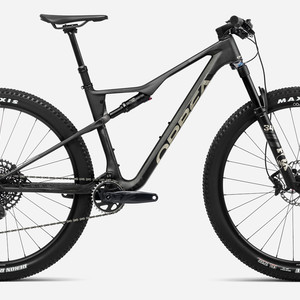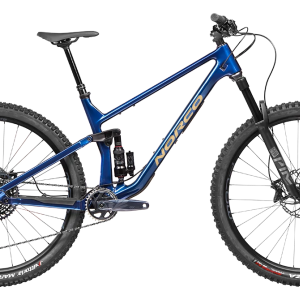2017 Transition Scout Carbon 3
(discontinued)
| Where To Buy | |||
|---|---|---|---|
Free shipping on orders over $50 (continental U.S. only).
International shipping available. Some exclusions apply. |
|||
Free shipping on orders over $50 (continental U.S. only).
International shipping available. Some exclusions apply. |
|||

Subscribing to long, low, and slack frame geometry, Bellingham-based Transition Bicycles designed the Scout to be a ripping 27.5-inch mid-travel trail bike. New for 2017, the frame is available in carbon. Built to ride down the mountain like a slopestyle bike with a little cushion, the lightweight package is also ready to pedal big miles getting up the next. Tucson, Arizona's wild mix of trails served as an excellent place for our female shredders to try it out during the 2017 Vital MTB Test Sessions.
Highlights
- Carbon frame
- 27.5-inch wheels
- 125mm (4.9-inches) of rear wheel travel // 140mm (5.5-inches) fork travel
- GiddyUp link suspension design
- Tapered headtube
- Tubes Inside Tubes internal cable routing
- Collet style main pivot hardware
- Integrated rubber chainstay protection
- Tire clearance up to 27.5x2.5-inches
- 73mm threaded bottom bracket shell with ISCG05 mounts
- 142mm rear spacing with Syntace X12 12mm through axle and universal Transition derailleur hanger
- Measured weight (size small, no pedals): 28.8-pounds (13.05kg)
- MSRP $5,099 USD
For 2017, the Transition Scout achieved next-level awesomeness with an all-new carbon frame. This pony dropped a substantial 1.3-pounds (600g) of weight over its aluminum predecessor and is ready to fly. Pegasus status has been achieved here. The carbon version kept all the great features of the aluminum Scout with no compromise in strength, and appears to have even gained a few improvements like a wider main pivot. Embodying the same GiddyUp Horst-link suspension design and long, low, and snappy geometry, the carbon Scout is even better at turning your everyday trail into a playground. With 140mm of front travel and 125mm out back, it's set to be capable and efficient while both pedaling and pumping. Transition pairs the frame with a 190x51mm RockShox Monarch RT3 Debonair shock.

Not just good-looking on paper, this 1X drivetrain specific bike is quite the looker in person. The paint job is clean and the Blood Orange color really pops. Fully guided internal cable routing for the rear brake and rear derailleur keep things looking super pro while making maintenance easier and silencing any cable rattle before it starts, which is a big advantage over the aluminum version. Though they lack the new Boost axle standard, Transition's line of carbon bikes are their most dialed yet. Adding to the already high appeal of the carbon Scout, the frame also has enough room for both a large water bottle and spare tube in the front triangle – even on the size small.
|
|
|
|
Our Pegasus, err, model for testing was the Scout Carbon 3. This is the most affordable build at $5,099 USD. Two other builds, the Scout Carbon 2 and Scout Carbon 1, are offered at $6,299 and $8,799, respectively. It's also available as a $2,999 frameset for creating your own custom build.
Geometry

Transition's description of the Scout’s geometry as "Progressive Playground Specific" should tell you just about everything you need to know. This bike is made for fun. The 67-degree headtube angle and long reach values across the size range make for a stable ride, while the short 425mm chainstays, a low 329mm measured bottom bracket height, and 125mm of rear travel give the bike that playful character. More good news for shorter riders are the Scout’s low standover height and short seat tube length as these tend to be trouble areas for many women. We pack a lot of awesome in smaller packages, right ladies? At 5'5", 5'6", and 5'7" (1.65, 1.68, and 1.70m) tall, we opted for the size small frame with a reach measurement of 406mm.
Suspension Analysis
Using the bike industry's leading linkage analysis software, André Santos, the Youtube suspension whiz, was able to determine a close approximation of the Scout's kinematics for the purpose of this review. These charts provide great insight into several key factors that impact how it rides. Those unfamiliar with these types of graphs should watch André's excellent series of suspension fundamentals videos. The results of his analysis are as follows:
|
|
|
|
Observations:
- The Transition Scout is a slightly progressive trail bike at 14%.
- It has good pedaling efficiency for a single-ring setup with anti-squat values close to 90-95% on a 32-tooth chainring, and close to 100% on a 30-tooth chainring.
- The anti-squat values decrease significantly throughout the travel, reducing the total amount of pedal kickback.
- Anti-rise of 43% at sag, meaning that the suspension is quite independent from braking forces.
- Overall, the Scout is a slightly progressive trail bike with good pedaling efficiency and a quite neutral braking.
How does science meet the dirt? Did our real life ride time confirm the analysis? It's back to Vital's testers to hear how the Scout performed on trail.
On The Trail
In search of fun trails and the limits of the mid-travel Scout, we headed to Tucson’s Mount Lemmon. Aspen Draw, Incinerator Ridge, Green Mountain, Bug Springs, Prison Camp, Molino Basin, and La Milagrosa trails offered a huge variety of rocky and rooty tech, loose corners, chunk, and some sweeping flow in between. The trails had all of us stoked while pushing the bike as far as we dared.
Jumping on the bike for initial setup was easy as things were pretty much where we wanted them. Decently wide 760mm RaceFace Ride bars. Short RaceFace Aeffect 50mm stem. Comfortable reach. All good there. When we moved to change the seat height, however, we ran into trouble. The KS Lev Integra dropper seatpost was way too short for all of us. The spec appears to be for those with shorter inseams and only offers 100mm of travel. Sad face. At least the KS Southpaw dropper lever was good. It allowed other controls to be moved all the way to the grip if required for those with smaller hands.
Finishing our setup, we dialed in the suspension to the recommended 33-35% (17-18mm) sag using RockShox's handy markings, rolled the bars to a comfortable position, and made personal adjustments to brake levers and saddle position. With everything in order it was time to grab the pack, some snacks, and hit the trail!

As soon as we started riding, the Transition Scout felt balanced and stable. The front end didn’t wander or float on climbs. It provided a predictable and forgiving platform for technical climbing that felt good, even fun, with great traction at the rear wheel. The relatively steep effective seat angle really assisted with seated climbing and helped us transition from seated to standing smoothly when it was time to drop the hammer. Even with a low 329mm bottom bracket height and rocks strewn all over the place, neither pedal nor chainring strikes were an issue with the 170mm cranks spec'd on the size small. We would cringe and brace for an impact that never came, and were able to keep on rolling unscathed.
The linkage design of the Scout creates a fairly neutral instantaneous center. This helps the Scout pedal over square-edged obstacles without hanging up. At the same time it provides support and forward motion. We didn’t feel the need to flip levers to climb. Even choppy, standing pedal strokes didn’t seem to rob much power from the pedals. While this bike weighed in at a respectable 28.8-pounds (13.05kg), it felt lighter and climbed more quickly than expected.

Having ridden Molino Basin and La Milagrosa trails a number of times on everything from a single-speed hardtail to a 160mm travel enduro bike, the 140/125mm Scout proved to be surprisingly capable. It performed more like a bigger bike than one might expect. The waterfall section of La Milagrosa serves as a good indicator of how stable a bike feels, and the Scout didn’t bobble or feel sketchy here. It was smooth and stable through the gnar. Yup, downhill riding was a hoot aboard this bike. The confidence the Scout gave the rider invited pushing the limits. While our initial ride utilized full travel on many occasions, we weren’t that surprised given what we were riding. The bike totally asked for it by being so ready to rally. When we did use all of the travel, rarely did we feel a hard bottom-out.
On smoother sections of trail the bike really came alive, hinting at great possibilities for those in very flowy terrain. We had a blast jumping and pumping while noting just how supportive and responsive it was.
Typical for a mid-travel bike capable of taking bigger hits, the suspension was a bit stiff on quick successive hits like the staircase rock sections of Bug Springs trail. The rider needed to stay on top of it more than when on a plush bigger-travel bike. For lighter riders, custom shock tuning could soften the compression damping a hair to aid in situations like this. While we often need to custom tune our suspension as light riders, the stock suspension tune would likely work perfectly well for those on size medium and larger frames.

To really dial things in and feel the bike out, we shuttled the Prison Camp trail while timing runs and noting differences in feel. We treated these runs like short enduro segments. The trail features a good mix of sprints, techy uphills, chunky downhills, tight switchbacks, some rad bermed turns, and small sections of rocks to pop over. Hammering at race pace felt pretty good for a bike with relatively little travel on offer. While there was some minor pedal bob, the effort we put in drove the bike forward while maintaining traction and not bogging down.
Typical for a mid-travel bike capable of taking bigger hits, the suspension was a bit stiff on quick successive hits. The rider needed to stay on top of it more than when on a plush bigger-travel bike.
Being able to dial in a bike to your personal style is not always possible, but the Scout allowed for a few different setups which is another positive. One tester found what felt best for her with the stock air volume setup, 35% rear sag, compression halfway between firm and soft, and a lower-than-recommended pressure in the front. Another tester – the lightest rider in the group – added one Bottomless Token to the RockShox Pike RC Solo Air fork and one band to the stock for a total of two fork Tokens and three shock bands. With a slight increase in air pressure, the sag ended up being about 25% front and rear. This gave her a very supportive platform and more of a race feel. The final rider found a great balance with the air volume setup just mentioned and 33% rear sag with the shock wide open.
We could debate all day whether “shampoo is better,” or “no, conditioner is better” (you read that in a Billy Madison voice, right?). But really, it boils down to personal preference. A more plush setup lends to plowing through rocks or rolling techy sections with more weight off the back. A stiffer setup promotes pumping and popping over rocks, dropping instead of rolling, and getting over the front end in a more aggressive style. Potāto, potäto. Both are good eats and this bike rides well either way.
On smoother sections of trail the bike really came alive, hinting at great possibilities for those in very flowy terrain. We had a blast jumping and pumping while noting just how supportive and responsive it was. The agile feel is greatly aided by a consistent and smooth ramp in the suspension.
Not jumping on the Boost axle bandwagon could actually be a good thing, specifically in a size small bike. Our lightest rider feels that she needs some compliance while racing through techy, rocky terrain in order to avoid deflection and maintain control. In this case, the additional stiffness Boost offers might not be a selling point. On the other hand, a much heavier and taller shredder might appreciate the move to the new standard.
Only our tallest 5'7" tester found the bike to be a little on the small side, which is in line with Transition's sizing recommendations.
Build Kit
The lack of gimmicky marketing or features sets this bike apart. Utilizing standard, easy to acquire parts lets the Scout shine without having to sell the rider on anything they don’t need or that would be difficult to maintain. Ride performance is largely dictated by geometry and suspension design, and you get what you pay for when it comes to the build kits.
|
|
|
|
RockShox’s Monarch RT3 Debonair rear shock offers the ability to decrease the volume with easy-to-acquire bands. During setup there was a noticeable clunk at the equalizing point but it wasn’t felt on the trail.
The 140mm travel RockShox Pike RC Solo Air fork could be run at a wide range of of air pressures and compression settings, and simple-to-install Bottomless Tokens help ramp up the end of the stroke to meet rider preference and balance the bike better. Even with this adjustability, lighter riders might require lighter compression tuning to get the most from the fork.
As expected given the rocky Tucson terrain, the EXO casing on the 2.3-inch Maxxis Minion DHR II dual compound rear tire wasn't enough to resist rock punctures, but the tread pattern provided great traction. We beefed up to a 2.3-inch Maxxis Aggressor with a Double Down casing and didn’t have any further issues. Up front is a 2.3-inch Maxxis Minion DHF EXO dual compound tire. For being on decomposed granite that you could bag for kitty litter, we were surprisingly confident in our ability to stick-it through the corners.
The lack of gimmicky marketing or features sets this bike apart. Utilizing standard, easy to acquire parts lets the Scout shine without having to sell the rider on anything they don’t need or that would be difficult to maintain.
Maximum seatpost insertion for the size small frame is listed as 145mm. The stock KS Lev Integra was 335mm total length with 100mm of travel (larger frame sizes spec 125 or 150mm droppers). All the test riders are towards the upper end of the size small Scout’s height suggestion guide. With 30 to 31.5-inch (76 to 80cm) inseams, we had the minimum insertion line about an inch above the seat clamp. Yikes. Also, when riding a bike on steep and rowdy trails, a 100mm dropper doesn’t quite cut it. The saddle gets all up in our business. We took to lowering the post into the frame at the top of the descent like it was 2000 and late. After the first ride we replaced the stock dropper with a 125mm travel post but still could have gone for more travel on this terrain (provided it would fit). Yeah, size does matter in some departments. For riders with an inseam shorter than 28-inches (71cm) – likely those who fall in the mid to lower height range for a size small – the wee 100mm dropper would likely be fine.

SRAM's Guide R brakes with 180mm rotors modulated well and were not overly grabby. However, after a week of riding hard and wearing down the brake pads, the pad contact adjust feature of the SRAM Guide RSC brakes would have been nice. We do really like the tool-free reach adjust of the brakes, however. It’s great for small hands and pretty much a mandatory feature for us.
The Carbon Scout 3 is spec’d with a SRAM GX drivetrain and XG1150 10-42 tooth cassette which is a good deal heavier than the components in the other builds, but GX has proven to be durable. If weight is not a concern this is a great place to save some dollars. Drivetrain performance was flawless during testing, and testers who typically run SRAM XX1 or Eagle had no major complaints. One tester changed the stock Race Face 32-tooth chainring to a 30-tooth for tackling extra-technical climbs. The process was a little involved as the Race Face Aeffect cranks required extraction and the Cinch ring swap required old-school bottom bracket tools. Finally, though no chains were dropped during testing, we're still fans of chainguides. Luckily the Scout has ISCG05 tabs and is ready to accept one.
The Carbon 3 build wheelset is comprised of SRAM MTH 716/746 hubs with Race Face AR 27mm rims which are not shipped tubeless ready. The Carbon 2 build has Stan’s NoTubes Arch MK3 rims with Neo hubs, which are a definite upgrade with increased durability, better tubeless performance, and are over half a pound lighter. That said, the Race Face rims escaped Tucson with only a slight wobble to show for it.
Recommended upgrades to the Scout Carbon 3 build kit would be a longer travel dropper post if you can, lighter and faster-engaging wheels, and possibly Guide RSC brakes if you need the pad adjust feature. Also, ladies, if you prefer saddles with a deeper channel for soft tissue relief, you’ll likely want to swap out the ANVL Forge Stealth saddle. While the bike was awesome in so many other aspects, the saddle wasn't the most female-friendly for some of us.
Long Term Durability
The carbon Scout frame has many features designed to make maintenance much easier. Working with the cable routing, for example, was very simple thanks to the tubes-in-tubes internal routing design. This cuts out the headache of fishing cables through the frame with a wire and flashlight. The threaded bottom bracket is also preferred for maintenance and can stave off the creaking Press Fit bottom brackets often suffer. Sealed cartridge bearings are also straightforward to replace, the collet-style main pivot hardware stays snug, and Transition makes everything easy by providing torque specs and an assembly diagram. They also conveniently make everything you need for service available through their website.
We recommend putting protective vinyl or 3M Mastic tape on the downtube, arch of the rear triangle, and inside of the seatstay. The integrated rubber chainstay protection will protect that area of the bike, but these other areas are also subjected to lots of abuse. Shuttling on tailgate pads and debris flying off the front tire can damage the downtube of a carbon beauty like this. In the rear, mud and debris will wear on that bridge, although there's a pretty good ~15mm of mud clearance with the stock 2.3-inch Maxxis tire.
Transition backs the frame with a two-year warranty and lifetime crash replacement policy.

What's The Bottom Line?
Transition really nailed the do-everything trail bike with the Scout Carbon, outperforming its mid-travel label in rough, rocky, downhill terrain while conquering technical climbs with surprising ease. When the trail smoothed out the Scout could fully open up and fly while having fun popping off everything in sight. The geometry is on point for a stable yet playful ride. Low standover height also makes this mythical beast a great option for the ladies.
Capable and confidence inspiring. Fast and efficient. Poppy and playful. This 140/125mm travel bike can put down miles chasing cross-country friends, absolutely rock it on the flowy stuff, or take on steep, techy trails while shuttling without much worry. For what it's worth, not only did this bike feel fast, it also beat the other trail and enduro bikes we ladies tested in timed downhill runs that included multiple short steep climbs.
The Scout is ideal for riders out to maximize their fun. If you find yourself on moderately technical descents often, are on the hunt for jumpy bonus lines, and don't want to be destroyed by the top of the hill so you can enjoy your well-earned descent, you'll really enjoy this ride. Does your lady ride bikes? The bike is for her, too – put a bow on it. The Scout was a blast to ride!
Visit www.transitionbikes.com for more details.
Vital MTB Rating
- Climbing: 4 stars - Excellent
- Descending: 4 stars - Excellent
- Fun Factor: 5 stars - Spectacular
- Value: 4 stars - Excellent
- Overall Impression: 4.5 stars - Outstanding
Bonus Gallery: 27 photos of the 2017 Transition Scout Carbon #3 up close and in action
About The Reviewers
Krista Rust- Age: "I've been told I act 12" // Years Riding MTB: 14 // Height: 5'5" (1.65m) // Weight: 118-pounds (53.5kg)
"I love racing down technical trails." As a racer at heart, Krista's focus is on going fast and racking up results. She brings an engineering perspective to the tech side, isn't afraid to try the burly moves or be friends with Tucson's tarantulas, and absolutely hammers on the way downhill.
Amanda Wentz - Age: 35 // Years Riding MTB: 10+ // Height: 5'6" (1.68m) // Weight: 135-pounds (61.2kg)
"I am really trying to be more smooth but somehow I still end up just smashing my way through things." Over the last decade, Amanda has soaked up all aspects of mountain biking and continues to push herself to progress. She's a personal trainer and mountain bike coach and loves knowing what her gear is doing and why.
Courtney Steen - Age: 29 // Years Riding MTB: 9 // Height: 5'7" (1.70m) // Weight: 155-pounds (70.3kg)
"Going downhill puts a smile on my face and I climb for ice cream, pizza, and beer." Courtney routinely shocks the boys with her speed and has experience in various disciplines. Today she travels the country in an RV in search of the next best trail and writes women's reviews for Vital MTB. Her technical background helps her think critically about products and how they can be improved.

About Test Sessions
For five years a dedicated crew of Vital MTB testers have been bringing you the most honest, unbiased reviews you'll find anywhere. This time around we rode 2017's most exciting trail, all-mountain, and enduro bikes on a wide variety of rowdy trails in Tucson, Arizona. Reviews can be accessed 24/7 in our Product Guide. Test Sessions was made possible with the help of Arizona Cyclist. Tester gear provided by Troy Lee Designs, Specialized, Five Ten, ZOIC, Sombrio, Race Face, and EVOC. All photos by Lear Miller.
Specifications
Rear: Maxxis Minion DHR II 27.5"x2.3" EXO Dual
| Where To Buy | |||
|---|---|---|---|
Free shipping on orders over $50 (continental U.S. only).
International shipping available. Some exclusions apply. |
|||
Free shipping on orders over $50 (continental U.S. only).
International shipping available. Some exclusions apply. |
|||



































12 comments
Post a reply to: Review - 2017 Transition Scout Carbon from Vital MTB Test Sessio